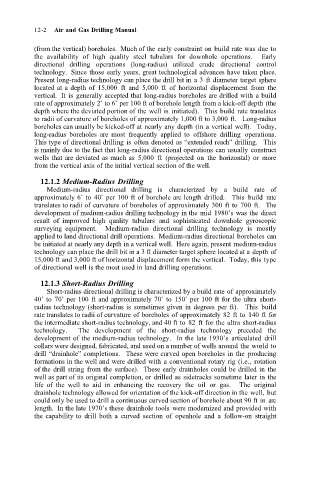Page 638 - Air and Gas Drilling Manual
P. 638
12-2 Air and Gas Drilling Manual
(from the vertical) boreholes. Much of the early constraint on build rate was due to
the availability of high quality steel tubulars for downhole operations. Early
directional drilling operations (long-radius) utilized crude directional control
technology. Since those early years, great technological advances have taken place.
Present long-radius technology can place the drill bit in a 3 ft diameter target sphere
located at a depth of 15,000 ft and 5,000 ft of horizontal displacement from the
vertical. It is generally accepted that long-radius boreholes are drilled with a build
rate of approximately 2˚ to 6˚ per 100 ft of borehole length from a kick-off depth (the
depth where the deviated portion of the well is initiated). This build rate translates
to radii of curvature of boreholes of approximately 1,000 ft to 3,000 ft. Long-radius
boreholes can usually be kicked-off at nearly any depth (in a vertical well). Today,
long-radius boreholes are most frequently applied to offshore drilling operations.
This type of directional drilling is often denoted as “extended reach” drilling. This
is mainly due to the fact that long-radius directional operations can usually construct
wells that are deviated as much as 5,000 ft (projected on the horizontal) or more
from the vertical axis of the initial vertical section of the well.
12.1.2 Medium-Radius Drilling
Medium-radius directional drilling is characterized by a build rate of
approximately 6˚ to 40˚ per 100 ft of borehole arc length drilled. This build rate
translates to radii of curvature of boreholes of approximately 300 ft to 700 ft. The
development of medium-radius drilling technology in the mid 1980’s was the direct
result of improved high quality tubulars and sophisticated downhole gyroscopic
surveying equipment. Medium-radius directional drilling technology is mostly
applied to land directional drill operations. Medium-radius directional boreholes can
be initiated at nearly any depth in a vertical well. Here again, present medium-radius
technology can place the drill bit in a 3 ft diameter target sphere located at a depth of
15,000 ft and 3,000 ft of horizontal displacement form the vertical. Today, this type
of directional well is the most used in land drilling operations.
12.1.3 Short-Radius Drilling
Short-radius directional drilling is characterized by a build rate of approximately
40˚ to 70˚ per 100 ft and approximately 70˚ to 150˚ per 100 ft for the ultra short-
radius technology (short-radius is sometimes given in degrees per ft). This build
rate translates to radii of curvature of boreholes of approximately 82 ft to 140 ft for
the intermediate short-radius technology, and 40 ft to 82 ft for the ultra short-radius
technology. The development of the short-radius technology preceded the
development of the medium-radius technology. In the late 1930’s articulated drill
collars were designed, fabricated, and used on a number of wells around the world to
drill “drainhole” completions. These were curved open boreholes in the producing
formations in the well and were drilled with a conventional rotary rig (i.e., rotation
of the drill string from the surface). These early drainholes could be drilled in the
well as part of its original completion, or drilled as sidetracks sometime later in the
life of the well to aid in enhancing the recovery the oil or gas. The original
drainhole technology allowed for orientation of the kick-off direction in the well, but
could only be used to drill a continuous curved section of borehole about 90 ft in arc
length. In the late 1970’s these drainhole tools were modernized and provided with
the capability to drill both a curved section of openhole and a follow-on straight

